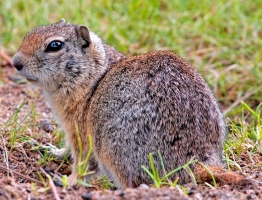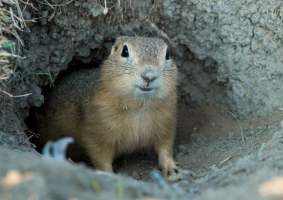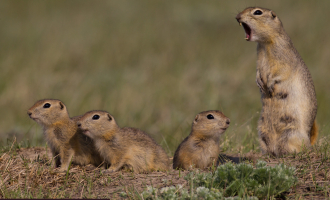 Richardson's ground squirrels are native to the short grass prairies of western Canada; they are most common in the southern areas of Alberta, Saskatchewan, and Manitoba. They can also be found in suburban areas, where they may dig tunnels under patios and sidewalks!
Richardson's ground squirrels are native to the short grass prairies of western Canada; they are most common in the southern areas of Alberta, Saskatchewan, and Manitoba. They can also be found in suburban areas, where they may dig tunnels under patios and sidewalks! Also known as gophers or prairie dogs, they have complex burrow systems. Richardson's ground squirrels are herbivores that eat grasses, plants, seeds, and grains. They will, if given the opportunity, scavenge meat, such as roadkills, but they do not kill either their own species or other species for food. Moreover, they normally do not eat the eggs of ground-nesting birds.  Active during the day for about 8-10 hours in the spring and summer, they act as lookouts for each other, alerting to danger. They then hibernate underground for up to eight months. In total, Richardsonís ground squirrels spend only about
15% of their lifetime above ground!
Active during the day for about 8-10 hours in the spring and summer, they act as lookouts for each other, alerting to danger. They then hibernate underground for up to eight months. In total, Richardsonís ground squirrels spend only about
15% of their lifetime above ground! Richardson's ground squirrels are one of the few native grassland mammals that are easily seen by the casual observer. They get used to humans and often seek handouts from picnic tables.  Richardson's ground squirrels produce only one litter per year. The litter,
usually of 6 or 7 infants, is born underground after a 23-day pregnancy, and juveniles first appear
above ground when 28-30 days old.
Richardson's ground squirrels produce only one litter per year. The litter,
usually of 6 or 7 infants, is born underground after a 23-day pregnancy, and juveniles first appear
above ground when 28-30 days old.
Although the potential life span for males is 3 years, less than 1% of males survive to this age. The potential life span for females is 5 years, but most live only 2 to 4 years. People who are concerned about raptor populations have an interest in maintaining and even expanding populations of Richardsonís ground squirrels as prey, to ensure the well-being of species such as falcons, hawks, and burrowing owls. In fact, Richardson's ground squirrels, either as adults or infants, can account for as much as 80% of the diet of the red-tailed hawk, the prairie falcon, the long-tailed weasel, the North American badger, and the coyote. Other predators include the Prairie rattle snake, red foxes, great horned owls, and the bald eagle. Richardson's ground squirrels may carry diseases like tularemia and plague, both of which which can be transmitted to humans. Burrowing owls nest in ground squirrel burrows that have been enlarged by animals such as badgers, so the best habitats for burrowing owls are large tracts of prairie occupied by both Richardsonís ground squirrels and badgers. Other animals that seek refuge in ground squirrel burrow systems include small mammals such as field mice and voles, other vertebrates such as salamanders, and many invertebrates. Bumblebees, important pollinators of prairie plants, often nest in ground squirrel burrows. |